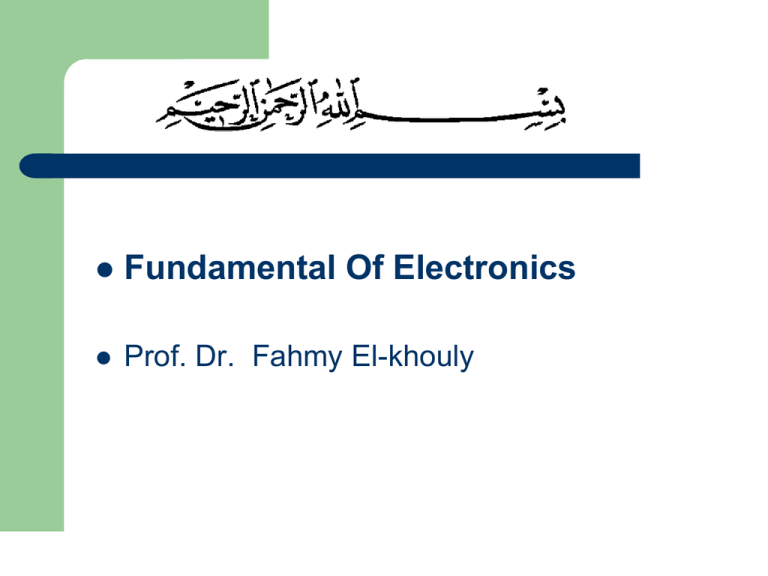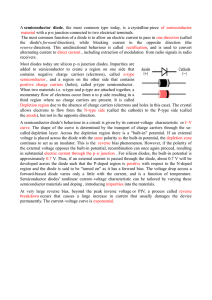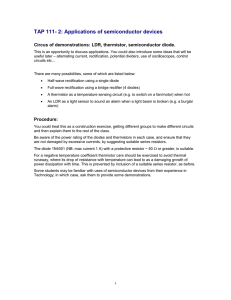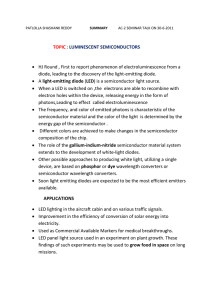
Fundamental Of Electronics
Prof. Dr. Fahmy El-khouly
•
•
•
•
•
•
•
•
Weighting of assessments:
Semester work
Report assignments
Practical Examination
-Quizzes
-Mid-Term Exam
- Final-Term Exam
Total
10 (Degrees)
10 (Degrees)
10 (Degrees)
10 (Degrees)
20 (Degrees)
40 (Degrees)
100 (Degrees)
10 %
10 %
10 %
10 %
20 %
40 %
100 %
• 6- List of References :
• R.L.Boylestad and L.Nashelsky, "Electronic devices and
circuit theory", 10th edition Pearson Prentice Hall, 2009.
COURSE Objectives:
- Enrich the student knowledge about basic Diode applications.
- Understand the characteristics of PN Junction, BJT and FET.
- Develop the student ability to analyze Diode, BJT and FET
circuits.
- Develops the knowledge and ability to design active electronic
circuits using diodes, bipolar and field effect transistors.
Intended Learning Outcomes (ILOs):
A : Knowledge and understanding:
On completing this course, students will be able to:
–
–
–
–
List the different properties of semiconductor materials.
Explain the operation of PN junctions.
Describe the characteristics of diode and it's applications.
Explain the operation of BJT and FET transistors
B-Intellectual
–
–
–
–
Skills: مهارات ذهنية
b1- Solve Diode Circuit problems.
b2- Create diode circuits for certain specifications
b3- Classify the difference between BJT and FET Transistors.
b4- Calculate the Q-point of BJT and FET.
C-Professional and Practical Skills مهارات احترافية وعملية ة
c1- Implement simple electronic circuit to meet specific needs..
c2- Perform simple Lab experiments.
C3- Collect information from collected data in the lab.
c4- Read datasheets of different types of electronics components.
D- General and Transferable Skills مهارات اتصال وعامة
d1- Use IT effectively.
d2- Work in a team or individually
d3- Find alternative solutions for engineering problems.
Chapter 1
Semiconductor
Diodes
1- IDEAL DIODE
The characteristics of an ideal diode
are those of a switch that can
conduct current in only one
direction
The ideal diode, therefore, is a short circuit
for the region of conduction.
The ideal diode, therefore, is an open
circuit in the region of nonconduction
Figure 1.1 Ideal diode:
(a) symbol; (b) characteristics.
2. SEMICONDUCTOR MATERIALS
The term conductor is applied to any material that will support a generous
flow of charge when a voltage source of limited magnitude is applied across
its terminals.
An insulator is a material that offers a very low level of conductivity under
pressure from an applied voltage source.
A semiconductor, therefore, is a material that has a conductivity level
somewhere between the extremes of an insulator and a conductor.
Orbiting: يدور فى مدار
Nucleus: نواة
valence: وحدة قدرة اتحاد الذرات
Figure 1.6 Atomic structure: (a) germanium;
(b) silicon.
Figure 1.7 Covalent bonding of the silicon atom.
Covalent: وحدة قدرة اتحاد الذرات
Intrinsic طبيعىmaterials are those semiconductors that have been carefully
refined to reduce the impurities to a very low level—essentially as pure as
can be made available through modern technology.
At room temperature there are approximately 1.5* 1010 free carriers in a
cubic centimeter of intrinsic silicon material.
The free electrons in the material due only to natural causes are referred to
as intrinsic carriers.
An increase in temperature of a semiconductor can result in a substantial
increase in the number of free electrons in the material.
Semiconductor materials such as Ge and Si that show a reduction in
resistance with increase in temperature are said to have a negative
temperature coefficient.
3. EXTRINSIC MATERIALS n- AND p-TYPE
A semiconductor material that has been subjected to the doping process is
called an extrinsic material.
n-Type Material
impurity atoms into a germanium or silicon base. The n-type is created by
introducing those impurity elements that have five valence electrons
(pentavalent), such as antimony, arsenic, and phosphorus.
Figure 1.9 Antimony impurity
in n-type material.
Diffused impurities with five valence electrons are called donor atoms.
The result is that at room temperature, there are a large number of carriers
(electrons) in the conduction level and the conductivity of the material
Increases significantly.
It is important to realize that even though a large number of “free” carriers
have been established in the n-type material, it is still electrically neutral since
ideally the number of positively charged protons in the nuclei is still equal to
the number of “free” and orbiting negatively charged electrons in the structure.
p-Type Material
The p-type material is formed by doping a pure germanium or silicon crystal
with impurity atoms having three valence electrons.
Figure 1.11 Boron impurity in
p-type material
Void: خالى
Note that there is now an insufficient number of electrons to complete the
covalent bonds of the newly formed lattice. The resulting vacancy is called a
hole and is represented by a small circle or positive sign due to the absence
of a negative charge. Since the resulting vacancy will readily accept a “free”
electron:
The diffused impurities with three valence electrons are called acceptor atoms.
Majority and Minority Carriers
In the intrinsic state, the number of free electrons in Ge or Si is due only to
those few electrons in the valence band that have acquired sufficient energy
from thermal or light sources to break the covalent bond or to the few impurities
that could not be removed.
The vacancies left behind in the covalent bonding structure represent our very
limited supply of holes.
In an n-type material, the number of holes has not hanged significantly from
this intrinsic level.
The net result, therefore, is that the number of electrons far outweighs the
number of holes. For this reason:
In an n-type material (Fig. 1.13a) the electron is called the majority carrier
and the hole the minority carrier.
In a p-type material the hole is the majority carrier and the electron is
the minority carrier.
4. SEMICONDUCTOR DIODE
This region of uncovered positive and negative ions is called the depletion
region due to the depletion of carriers in this region.
No Applied Bias (VD = 0 V)
In the absence of an applied bias voltage, the net flow of charge in any
one direction for a semiconductor diode is zero.
Figure 1.15 No-bias conditions
for a semiconductor diode.
Reverse-Bias Condition (VD < 0 V)
Figure 1.16 Reverse-biased
p-n junction.
Figure 1.17 Reverse-bias
conditions for a semiconductor
diode.
The current that exists under reverse-bias conditions is called the reverse
saturation current and is represented by Is
Forward-Bias Condition (VD > 0 V)
A semiconductor diode is forward-biased when the association p-type and
positive and n-type and negative has been established.
Figure 1.18 Forward-biased p-n
junction.
Figure 1.19 Silicon semiconductor diode characteristics.
Figure 1.21 Forward-bias
conditions for a semiconductor
diode.
The maximum reverse-bias potential that can be applied before entering the
Zener region is called the peak inverse voltage (referred to simply as the PIV
rating) or the peak reverse voltage (denoted by PRV rating).
Silicon versus Germanium
Silicon diodes have, in general, higher PIV and current rating and wider
temperature ranges than germanium diodes.
The disadvantage of silicon is the higher forward-bias voltage required to
reach the region of upward swing. It is typically of the order of magnitude of
0.7 V for commercially available silicon diodes and 0.3 V for germanium
diodes
The potential at which this rise occurs is commonly referred to as the offset,
threshold potential VT :
SEMICONDUCTOR DIODE NOTATION
DIODE EQUIVALENT CIRCUITS
Piecewise-Linear Equivalent Circuit
Figure 1.31 Defining the piecewise-linear
equivalent circuit using straight-line segments
to approximate the characteristic curve.
Simplified Equivalent Circuit
Ideal Equivalent Circuit
ZENER DIODES
LIGHT-EMITTING DIODES
light-emitting diode (LED) and the liquid-crystal display (LCD) are the tow
devices that emit light when properly biased. .
1- Describe in your own words the characteristics of the ideal diode and how
they determine the on and off states of the device. That is, describe why the
short-circuit and open-circuit equivalents are appropriate.
2- Describe the difference between n-type and p-type semiconductor materials.
3- Describe in your own words the conditions established by forward- and
reverse-bias conditions on a p-n junction diode and how the resulting current is
affected.
4- Find the piecewise-linear equivalent circuit for the diode of Fig. 1.19. Use a
straight line segment that intersects the horizontal axis at 0.7 V and best
approximates the curve for the region greater than 0.7 V.
5- Repeat Problem 4 for the diode of Fig. 1.29.





